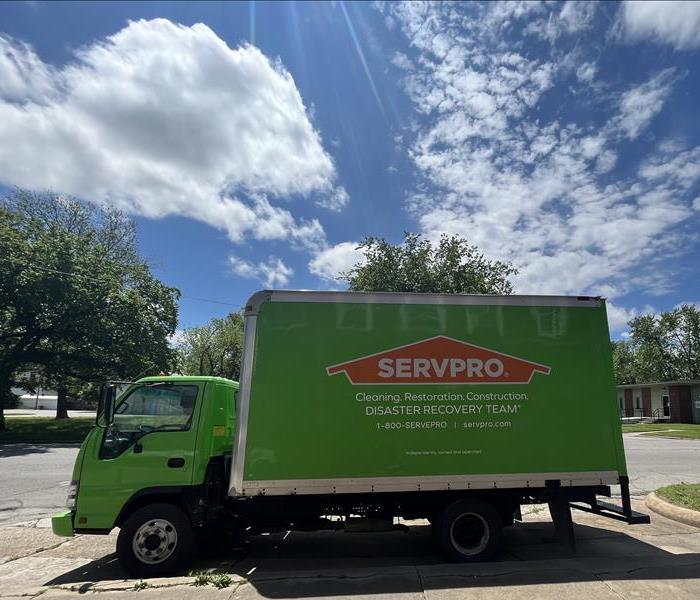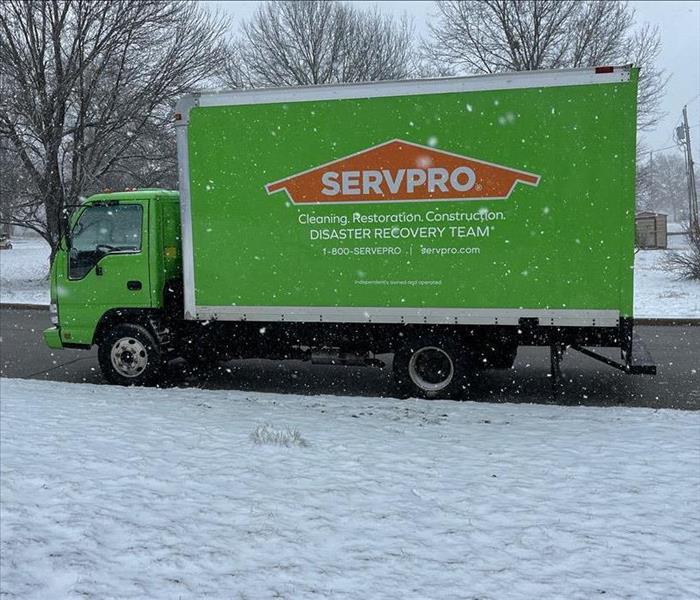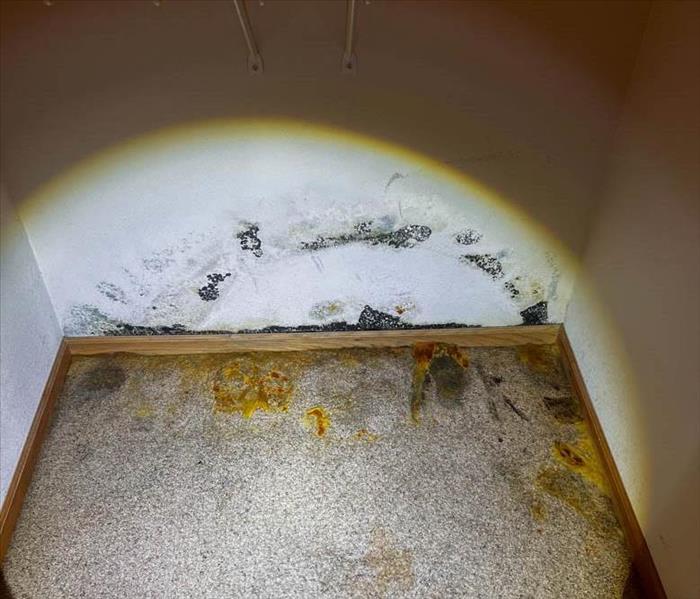Recent Mold Remediation Posts
Why Mold Disclosure Is Important for Home Sellers and Buyers
11/10/2024 (Permalink)
 When it comes to buying or selling a home, being honest about mold benefits everyone involved.
When it comes to buying or selling a home, being honest about mold benefits everyone involved.
Buying or selling a home is a big decision, and transparency is essential throughout the process. One key issue that can’t be ignored is mold. Mold can affect a property’s value and integrity, which is why disclosing any mold problems is crucial for both sellers and buyers. Whether you're selling or buying, understanding the importance of mold disclosure can help protect your investment and avoid unwanted surprises.
The Legal Obligation to Disclose Mold
In Missouri, sellers are legally required to disclose any known mold or water damage issues in their homes. Even if mold disclosure isn’t legally required where you live, it’s always a good idea to be upfront about any mold problems. Mold can cause damage to a home’s structure, which can significantly reduce its value. Failing to disclose mold could lead to legal troubles down the road.
Protecting the Buyer’s Investment
For buyers, mold disclosure is about protecting your investment. Mold can be expensive to clean up, and if it’s not disclosed, you could end up facing unexpected expenses after closing. Mold inspections are common during the home-buying process. If mold is discovered early, you can negotiate repairs or a lower purchase price to cover the cost of remediation.
How Mold Affects Property Value
Mold can reduce the value of a home, especially if it’s left untreated. Many potential buyers may be wary of purchasing a property with a mold history. For sellers, disclosing mold upfront helps build trust with potential buyers, making negotiations smoother and preventing last-minute deal-breakers.
Reducing Negotiation Conflicts
When mold is disclosed early in the process, it can lead to more productive negotiations. Sellers can offer to fix the issue or adjust the price to accommodate the cost of remediation. For buyers, knowing about the mold issue ahead of time allows them to make an informed decision and avoid feeling blindsided.
Questions Buyers Should Ask About Mold
If mold is disclosed during a home purchase, buyers should be proactive and ask these important questions:
- How was the mold discovered?
- What remediation steps have been taken?
- Is there documentation or warranties related to the mold cleanup?
Asking these questions helps ensure that the mold problem has been addressed and won’t become a recurring issue.
How Sellers Can Prepare for Mold Disclosure
Sellers should be prepared to handle mold disclosure by addressing any issues before listing their home. Hiring a professional mold inspector can help you identify any hidden mold problems and take care of them before potential buyers see them. Having professional documentation on hand gives buyers peace of mind and shows that you’ve taken steps to resolve the problem.
Benefits of Professional Mold Remediation
If mold is found, professional remediation is the best way to ensure the issue is properly handled. A trusted service like SERVPRO® can assess and remediate the mold, giving you the documentation you need to assure buyers that the problem has been thoroughly dealt with.
Honesty Benefits Both Parties
When it comes to buying or selling a home, being honest about mold benefits everyone involved. For sellers, disclosing mold builds trust and helps avoid legal issues. For buyers, mold disclosure provides peace of mind and allows for better decision-making.
If you’re selling a home and need mold remediation or if you’re buying and want a mold inspection, SERVPRO of Carthage/Joplin is here to help. Our team of experts will ensure the mold is handled professionally, so you can focus on the sale or purchase with confidence.
Mold in Schools: Risks and Prevention Measures
7/8/2024 (Permalink)
Mold growth in schools can present a variety of challenges for administrators, teachers, and students alike. While mold itself can be dangerous, its presence can lead to unpleasant odors, aesthetic concerns, and potential damage to school property. In this blog, we'll explore the risks associated with mold in schools and discuss proactive prevention measures to address this issue effectively.
Understanding the Risks
Mold is a type of fungus that thrives in damp, humid environments. In schools, mold growth can occur in areas with excess moisture, such as bathrooms, kitchens, and basements. While mold itself may not directly cause health issues, it can exacerbate respiratory problems in individuals with allergies or asthma. Additionally, mold can produce unpleasant odors and cause discoloration of surfaces, detracting from the overall cleanliness and appearance of the school environment.
Impact on Learning Environment
The presence of mold in schools can also impact the learning environment. Mold growth may result in the closure of classrooms or entire school buildings for remediation, disrupting educational activities and inconveniencing students and staff. Furthermore, the perception of mold in schools can negatively affect the school's reputation and credibility within the community.
Prevention Measures
Preventing mold growth in schools requires a proactive and multi-faceted approach. Here are some key prevention measures to consider:
- Maintain Proper Ventilation: Adequate ventilation is essential for reducing humidity levels and preventing moisture buildup, which can contribute to mold growth. Ensure that ventilation systems are properly maintained and functioning effectively.
- Address Moisture Issues Promptly: Address any water leaks, spills, or plumbing issues promptly to prevent excess moisture accumulation. Inspect bathrooms, kitchens, and other areas prone to moisture regularly and take corrective action as needed.
- Control Indoor Humidity: Keep indoor humidity levels below 60% to discourage mold growth. Use dehumidifiers in areas with high humidity and consider installing moisture meters to monitor humidity levels.
- Clean and Maintain HVAC Systems: Regularly clean and maintain HVAC systems to prevent mold growth in ductwork and air handling units. Replace filters as recommended and schedule professional inspections and cleanings as needed.
- Promote Good Housekeeping Practices: Encourage staff and students to practice good housekeeping habits, such as promptly cleaning up spills and avoiding leaving wet items or food debris in classrooms or common areas.
- Monitor Building Conditions: Regularly inspect school buildings for signs of water damage, such as stained ceilings, damp walls, or musty odors. Address any issues promptly to prevent mold growth and mitigate potential damage.
- Educate Staff and Students: Provide training and educational materials to staff and students on mold prevention and the importance of maintaining a clean and healthy school environment. Encourage proactive participation in mold prevention efforts.
Mold growth in schools can pose challenges for administrators, teachers, and students, impacting the cleanliness, safety, and functionality of the learning environment. While mold itself can cause damage, its presence can lead to aesthetic concerns, property damage, and disruptions to educational activities. By implementing proactive prevention measures, schools can minimize the risk of mold growth and create a clean, healthy, and conducive learning environment for all occupants.
Mold and Your Home's Structural Integrity
3/7/2024 (Permalink)
 SERVPRO is ready to take on your project anytime day or night.
SERVPRO is ready to take on your project anytime day or night.
Mold is not just an unsightly nuisance; it can also pose risks to the structural integrity of your home. Understanding the potential impact of mold on your property is crucial for homeowners. In this blog post, we'll explore the connection between mold and your home's structural integrity, as well as practical solutions to address and prevent mold-related issues.
How Mold Affects Structural Integrity
Mold thrives in damp and humid environments, making homes susceptible to its growth, especially in areas with water damage or high humidity levels. Mold can feed on organic materials present in building structures, such as wood, drywall, and insulation. Over time, prolonged exposure to mold can weaken these materials, compromising the structural integrity of your home.
Identifying Mold-Prone Areas
Certain areas of your home are more prone to mold growth due to factors like poor ventilation, water leaks, or high humidity. Pay close attention to spaces such as basements, attics, crawl spaces, and bathrooms. Regular inspections of these areas can help you identify early signs of mold and prevent it from causing extensive damage.
The Role of Moisture Control
Controlling moisture is a key factor in preventing mold and preserving your home's structural integrity. Address water leaks promptly, ensure proper ventilation in damp areas, and consider using dehumidifiers in spaces prone to high humidity. By controlling moisture, you create an environment less conducive to mold growth and protect your home from potential structural issues.
Regular Inspections and Maintenance
Regular home inspections and maintenance routines are essential for catching mold issues early on. Check for signs of water damage, such as stains on walls or ceilings, and address any leaks immediately. Inspect your roof, windows, and foundation for potential entry points where water could infiltrate, and seal any gaps or cracks to prevent moisture intrusion.
Professional Mold Remediation
If you discover mold in your home, it's crucial to enlist the help of professionals for mold remediation. Certified experts, like SERVPRO®, can assess the extent of the mold damage, develop a comprehensive remediation plan, and restore your home to a safe condition. Professional mold remediation is essential for ensuring that the mold is thoroughly and safely removed, preventing further structural damage.
Proper Ventilation
Proper ventilation is a key preventive measure against mold growth. Ensure that your home is well-ventilated, especially in areas prone to dampness. Use exhaust fans in bathrooms and kitchens, open windows when weather permits, and consider installing ventilation systems to improve air circulation and reduce humidity.
Regular Cleaning and Maintenance
Routine cleaning and maintenance of your home can significantly contribute to mold prevention. Keep surfaces dry, clean gutters regularly to prevent water buildup, and address any leaks or water damage promptly. Regular cleaning practices help eliminate the conditions that promote mold growth and protect your home's structural integrity.
Addressing Water Intrusion Immediately
Water intrusion is a primary contributor to mold growth and structural damage. Whether it's a leaky roof, plumbing issue, or foundation crack, address water intrusion immediately. Identify and fix the source of the problem to prevent ongoing moisture buildup and safeguard your home from potential structural issues.
Understanding the connection between mold and your home's structural integrity is vital for homeowners. By taking proactive measures, such as controlling moisture, conducting regular inspections, and enlisting professional mold remediation services when needed, you can protect your home from the detrimental effects of mold and ensure its long-term structural stability. Trust SERVPRO® to be your partner in addressing mold-related concerns and preserving the integrity of your home.
A Step-by-Step Guide to Mold Remediation
11/8/2023 (Permalink)
 Mold is a common concern for homeowners in Joplin, MO, given the diverse climate.
Mold is a common concern for homeowners in Joplin, MO, given the diverse climate.
Mold is a common concern for homeowners in Joplin, MO, given our diverse climate. At SERVPRO® of Carthage/Joplin, we understand the importance of a comprehensive mold remediation process. In this blog, we will take you through the step-by-step mold remediation process, helping you understand how we tackle mold issues in your home effectively.
Step 1: Initial Contact
The journey begins when you reach out to SERVPRO® of Carthage/Joplin. Our friendly team is ready to listen to your concerns and schedule a convenient appointment for an assessment.
Step 2: Inspection and Assessment
Our experienced technicians will arrive at your property and conduct a thorough inspection. We identify the extent of the mold infestation and assess the areas affected. This assessment helps us tailor our remediation plan to your specific needs.
Step 3: Containment
To prevent mold from spreading to unaffected areas, we establish containment. Our team uses advanced techniques such as negative air pressure chambers and physical barriers to isolate the affected areas.
Step 4: Air Filtration
We utilize high-efficiency particulate air (HEPA) filtration systems to capture mold spores from the air. This ensures a cleaner and safer environment during the remediation process.
Step 5: Mold Removal
The actual mold removal process involves the safe and efficient removal of mold-infested materials. Our team carefully follows industry best practices to eliminate mold colonies and prevent their return.
Step 6: Cleaning and Sanitization
We use specialized cleaning products to clean and sanitize the affected surfaces. This step helps eliminate mold residue and prevents future mold growth.
Step 7: Restoration
Once mold removal and cleaning are complete, our focus shifts to restoring your property to its pre-mold condition. This may involve minor repairs, such as replacing drywall or flooring.
Step 8: Final Inspection
Our experts conduct a final inspection to ensure that the mold remediation process has been successful. We want to ensure your property is mold-free and safe.
Step 9: Prevention Recommendations
To reduce the risk of future mold problems, we provide recommendations for preventive measures. This may include addressing any underlying moisture issues.
Mold remediation is a comprehensive process that requires expertise and precision. At SERVPRO® of Carthage/Joplin, we take pride in our step-by-step approach to mold remediation, ensuring your home is safe and mold-free. If you're dealing with mold issues in Joplin, MO, don't hesitate to contact us. We're here to help you protect your property and your peace of mind.
Say Goodbye to Mildew on Your Plants: Effective Prevention and Treatment Methods
5/19/2023 (Permalink)
Mildew is a common problem that many gardeners face, especially during periods of high humidity and moisture. It is a fungal infection that appears as a white or gray powdery substance on the leaves, stems and flowers of plants. Mildew can be harmful to plants, affecting their growth and overall health. However, there are several ways to get rid of mildew on plants, ranging from natural remedies to chemical treatments.
Prevention is Key
The first step in preventing mildew on plants is to avoid overwatering. Water your plants deeply and less frequently, ensuring that the soil is well-draining. Overwatering can lead to a buildup of moisture on the leaves and stems, providing an ideal environment for mildew to thrive. Additionally, ensure proper air circulation around your plants by trimming back overgrown foliage or positioning them in a location with adequate air movement.
Natural Remedies
Several natural remedies can help get rid of mildew on plants. A solution of 1 part milk to 9 parts water can be applied to the leaves of plants using a spray bottle. The milk helps to suppress the growth of mildew spores while also providing a source of nutrients for the plant. Another effective natural remedy is neem oil, which can be diluted with water and applied to the affected areas. Neem oil contains compounds that have antifungal properties and can help to prevent the spread of mildew.
Chemical Treatments
In cases of severe or persistent mildew, chemical treatments may be necessary. A range of fungicides is available, with varying degrees of effectiveness. Copper-based fungicides are often recommended for mildew control as they are effective and have a low risk of toxicity. However, care should be taken when using any chemical treatments, and the instructions on the label should be followed carefully.
Pruning Infected Areas
If mildew is present on only a few leaves or stems, pruning the infected areas may be the best course of action. This will help to prevent the spread of the infection to the rest of the plant. Make sure to use sterilized pruning shears to prevent the introduction of any other pathogens to the plant.
In conclusion, mildew can be a nuisance for plant owners, but with proper care and attention, it can be prevented and treated. Remember to maintain good plant hygiene, provide proper air circulation, and avoid overwatering. Additionally, natural remedies and chemical treatments can be used to get rid of mildew, and pruning infected areas can help to contain the infection. By taking these steps, you can help your plants to thrive and stay healthy.




 24/7 Emergency Service
24/7 Emergency Service
